Corporate Accounting Analysis at Insurance Australia Group Limited
VerifiedAdded on 2024/05/14
|13
|2829
|300
AI Summary
This report delves into the corporate accounting practices at Insurance Australia Group Limited, analyzing its cash flows statement, other comprehensive income statement, and accounting for corporate income tax. It provides insights into the company's financial performance and tax management strategies.
Contribute Materials
Your contribution can guide someone’s learning journey. Share your
documents today.
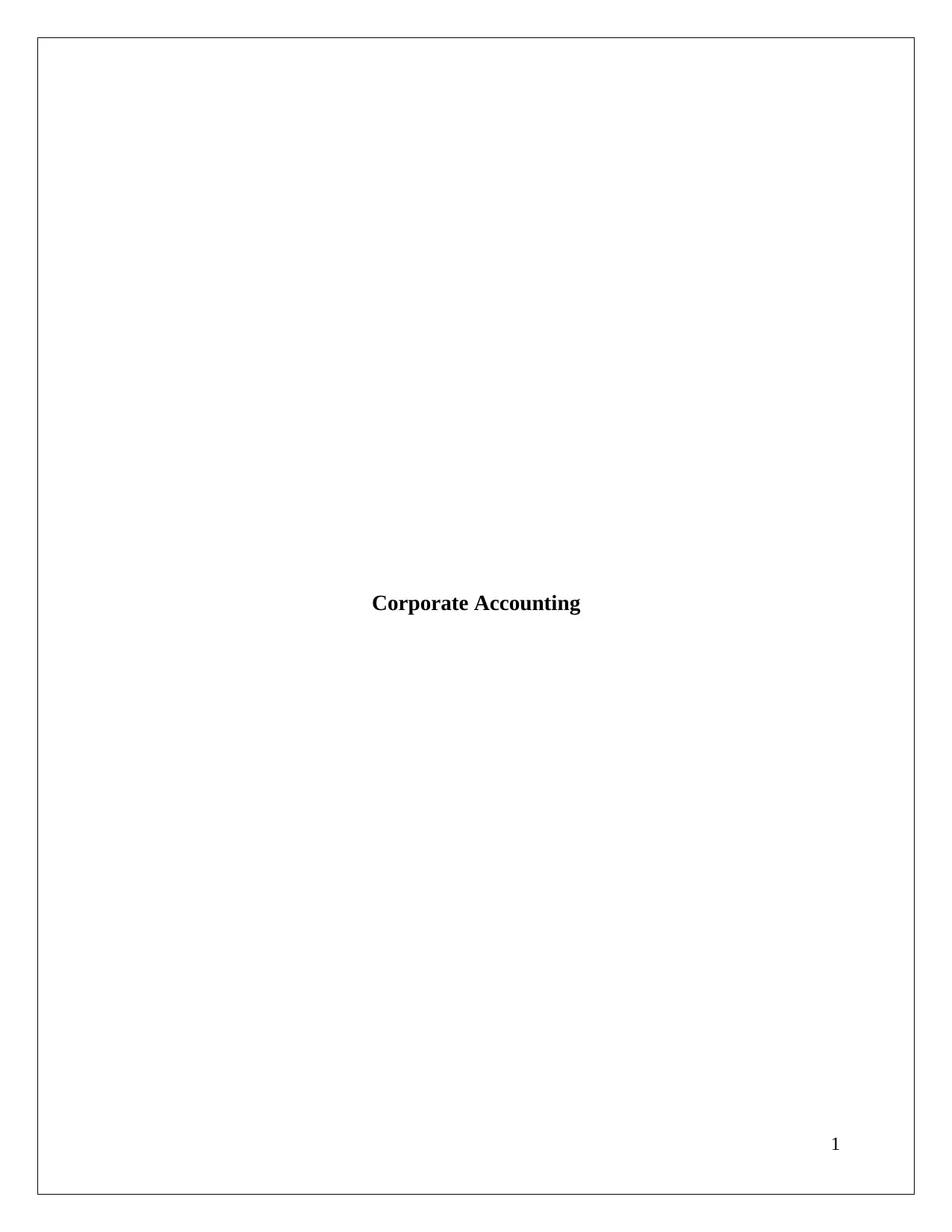
Corporate Accounting
1
1
Secure Best Marks with AI Grader
Need help grading? Try our AI Grader for instant feedback on your assignments.
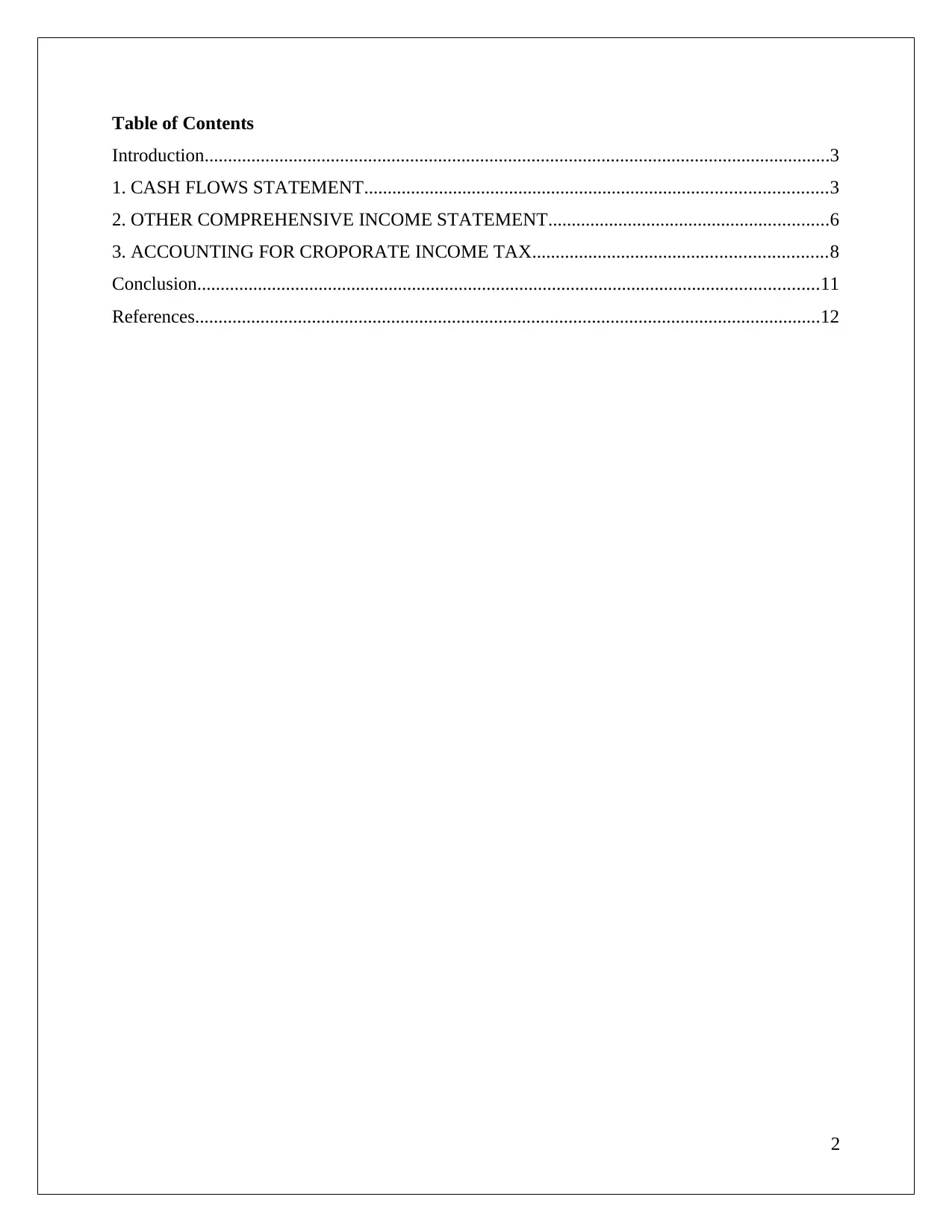
Table of Contents
Introduction......................................................................................................................................3
1. CASH FLOWS STATEMENT...................................................................................................3
2. OTHER COMPREHENSIVE INCOME STATEMENT............................................................6
3. ACCOUNTING FOR CROPORATE INCOME TAX...............................................................8
Conclusion.....................................................................................................................................11
References......................................................................................................................................12
2
Introduction......................................................................................................................................3
1. CASH FLOWS STATEMENT...................................................................................................3
2. OTHER COMPREHENSIVE INCOME STATEMENT............................................................6
3. ACCOUNTING FOR CROPORATE INCOME TAX...............................................................8
Conclusion.....................................................................................................................................11
References......................................................................................................................................12
2
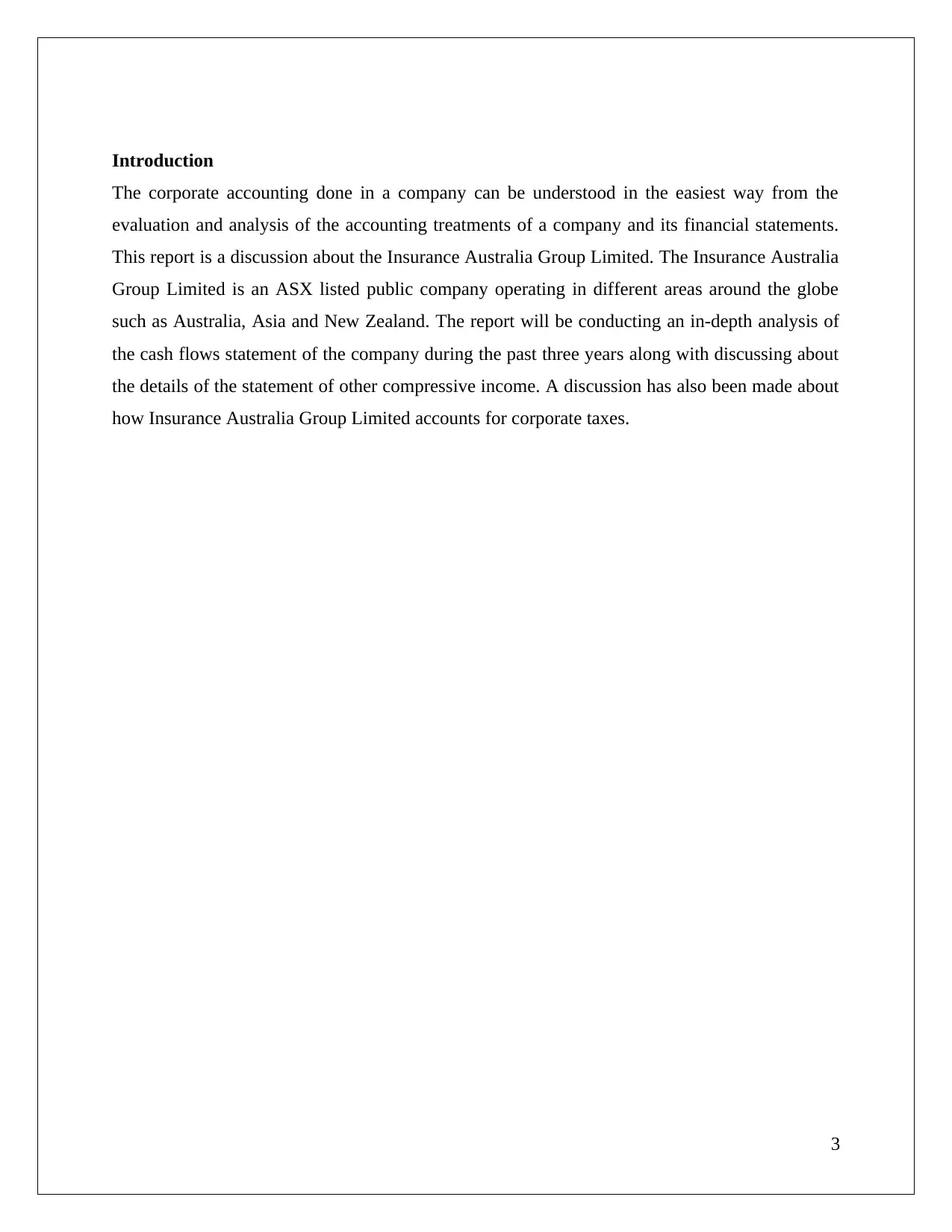
Introduction
The corporate accounting done in a company can be understood in the easiest way from the
evaluation and analysis of the accounting treatments of a company and its financial statements.
This report is a discussion about the Insurance Australia Group Limited. The Insurance Australia
Group Limited is an ASX listed public company operating in different areas around the globe
such as Australia, Asia and New Zealand. The report will be conducting an in-depth analysis of
the cash flows statement of the company during the past three years along with discussing about
the details of the statement of other compressive income. A discussion has also been made about
how Insurance Australia Group Limited accounts for corporate taxes.
3
The corporate accounting done in a company can be understood in the easiest way from the
evaluation and analysis of the accounting treatments of a company and its financial statements.
This report is a discussion about the Insurance Australia Group Limited. The Insurance Australia
Group Limited is an ASX listed public company operating in different areas around the globe
such as Australia, Asia and New Zealand. The report will be conducting an in-depth analysis of
the cash flows statement of the company during the past three years along with discussing about
the details of the statement of other compressive income. A discussion has also been made about
how Insurance Australia Group Limited accounts for corporate taxes.
3
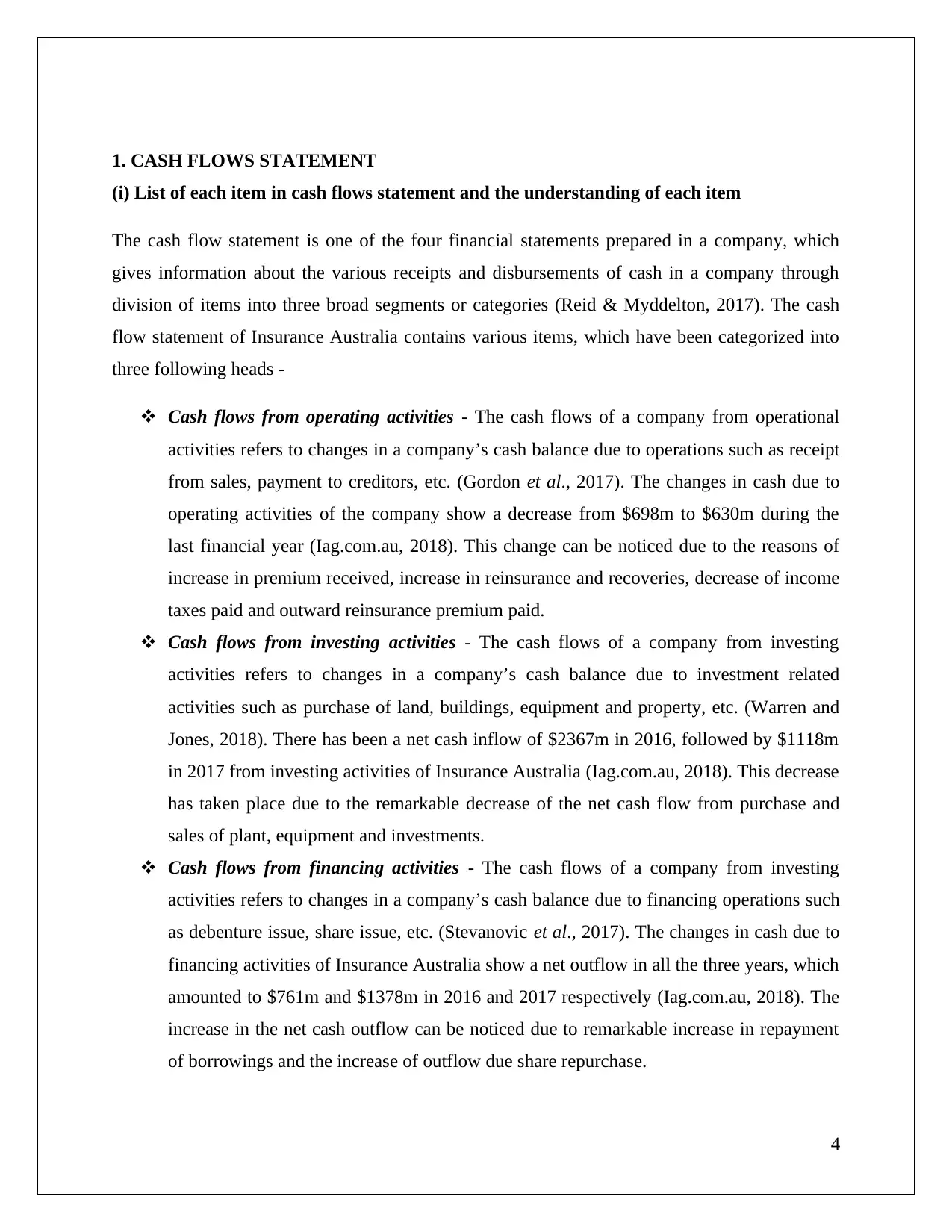
1. CASH FLOWS STATEMENT
(i) List of each item in cash flows statement and the understanding of each item
The cash flow statement is one of the four financial statements prepared in a company, which
gives information about the various receipts and disbursements of cash in a company through
division of items into three broad segments or categories (Reid & Myddelton, 2017). The cash
flow statement of Insurance Australia contains various items, which have been categorized into
three following heads -
Cash flows from operating activities - The cash flows of a company from operational
activities refers to changes in a company’s cash balance due to operations such as receipt
from sales, payment to creditors, etc. (Gordon et al., 2017). The changes in cash due to
operating activities of the company show a decrease from $698m to $630m during the
last financial year (Iag.com.au, 2018). This change can be noticed due to the reasons of
increase in premium received, increase in reinsurance and recoveries, decrease of income
taxes paid and outward reinsurance premium paid.
Cash flows from investing activities - The cash flows of a company from investing
activities refers to changes in a company’s cash balance due to investment related
activities such as purchase of land, buildings, equipment and property, etc. (Warren and
Jones, 2018). There has been a net cash inflow of $2367m in 2016, followed by $1118m
in 2017 from investing activities of Insurance Australia (Iag.com.au, 2018). This decrease
has taken place due to the remarkable decrease of the net cash flow from purchase and
sales of plant, equipment and investments.
Cash flows from financing activities - The cash flows of a company from investing
activities refers to changes in a company’s cash balance due to financing operations such
as debenture issue, share issue, etc. (Stevanovic et al., 2017). The changes in cash due to
financing activities of Insurance Australia show a net outflow in all the three years, which
amounted to $761m and $1378m in 2016 and 2017 respectively (Iag.com.au, 2018). The
increase in the net cash outflow can be noticed due to remarkable increase in repayment
of borrowings and the increase of outflow due share repurchase.
4
(i) List of each item in cash flows statement and the understanding of each item
The cash flow statement is one of the four financial statements prepared in a company, which
gives information about the various receipts and disbursements of cash in a company through
division of items into three broad segments or categories (Reid & Myddelton, 2017). The cash
flow statement of Insurance Australia contains various items, which have been categorized into
three following heads -
Cash flows from operating activities - The cash flows of a company from operational
activities refers to changes in a company’s cash balance due to operations such as receipt
from sales, payment to creditors, etc. (Gordon et al., 2017). The changes in cash due to
operating activities of the company show a decrease from $698m to $630m during the
last financial year (Iag.com.au, 2018). This change can be noticed due to the reasons of
increase in premium received, increase in reinsurance and recoveries, decrease of income
taxes paid and outward reinsurance premium paid.
Cash flows from investing activities - The cash flows of a company from investing
activities refers to changes in a company’s cash balance due to investment related
activities such as purchase of land, buildings, equipment and property, etc. (Warren and
Jones, 2018). There has been a net cash inflow of $2367m in 2016, followed by $1118m
in 2017 from investing activities of Insurance Australia (Iag.com.au, 2018). This decrease
has taken place due to the remarkable decrease of the net cash flow from purchase and
sales of plant, equipment and investments.
Cash flows from financing activities - The cash flows of a company from investing
activities refers to changes in a company’s cash balance due to financing operations such
as debenture issue, share issue, etc. (Stevanovic et al., 2017). The changes in cash due to
financing activities of Insurance Australia show a net outflow in all the three years, which
amounted to $761m and $1378m in 2016 and 2017 respectively (Iag.com.au, 2018). The
increase in the net cash outflow can be noticed due to remarkable increase in repayment
of borrowings and the increase of outflow due share repurchase.
4
Paraphrase This Document
Need a fresh take? Get an instant paraphrase of this document with our AI Paraphraser
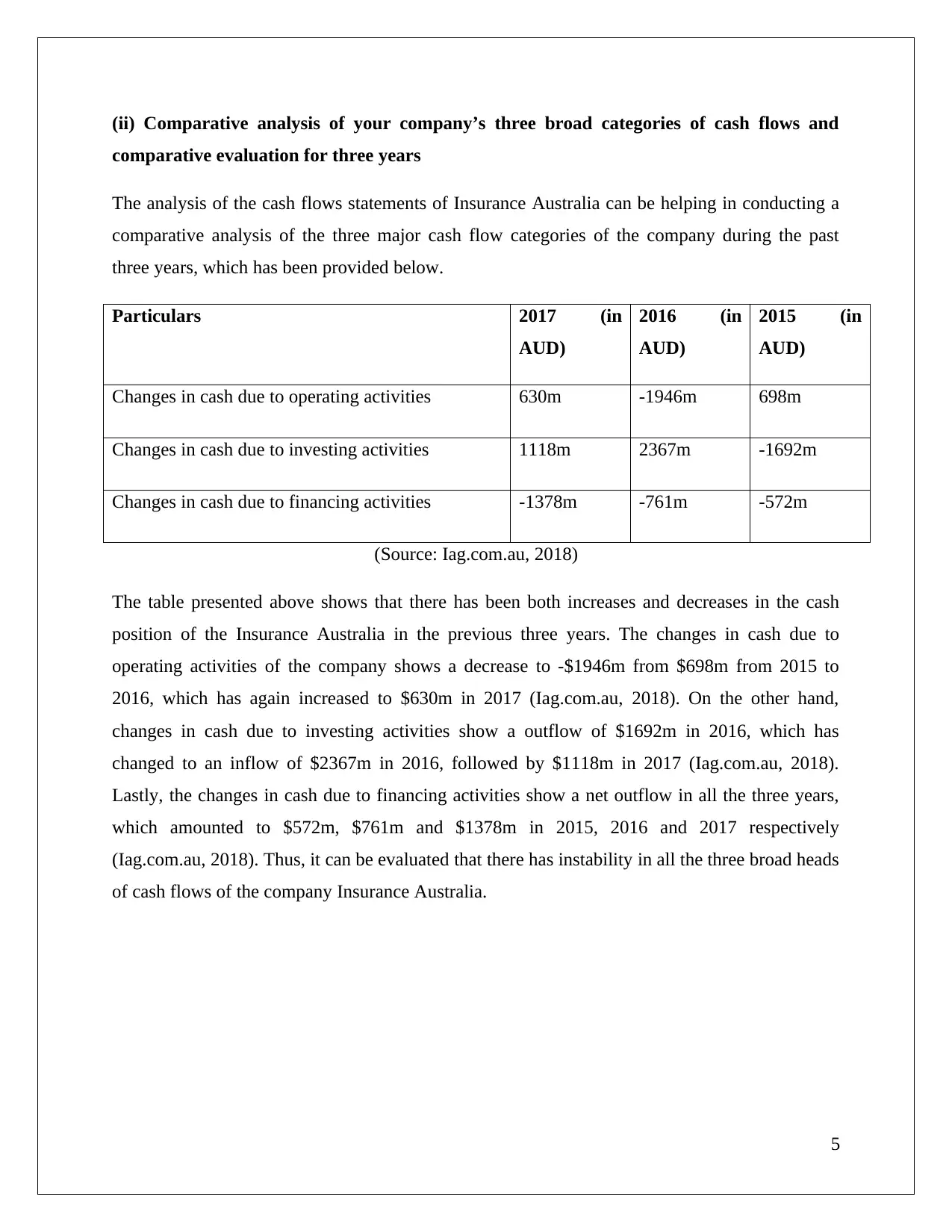
(ii) Comparative analysis of your company’s three broad categories of cash flows and
comparative evaluation for three years
The analysis of the cash flows statements of Insurance Australia can be helping in conducting a
comparative analysis of the three major cash flow categories of the company during the past
three years, which has been provided below.
Particulars 2017 (in
AUD)
2016 (in
AUD)
2015 (in
AUD)
Changes in cash due to operating activities 630m -1946m 698m
Changes in cash due to investing activities 1118m 2367m -1692m
Changes in cash due to financing activities -1378m -761m -572m
(Source: Iag.com.au, 2018)
The table presented above shows that there has been both increases and decreases in the cash
position of the Insurance Australia in the previous three years. The changes in cash due to
operating activities of the company shows a decrease to -$1946m from $698m from 2015 to
2016, which has again increased to $630m in 2017 (Iag.com.au, 2018). On the other hand,
changes in cash due to investing activities show a outflow of $1692m in 2016, which has
changed to an inflow of $2367m in 2016, followed by $1118m in 2017 (Iag.com.au, 2018).
Lastly, the changes in cash due to financing activities show a net outflow in all the three years,
which amounted to $572m, $761m and $1378m in 2015, 2016 and 2017 respectively
(Iag.com.au, 2018). Thus, it can be evaluated that there has instability in all the three broad heads
of cash flows of the company Insurance Australia.
5
comparative evaluation for three years
The analysis of the cash flows statements of Insurance Australia can be helping in conducting a
comparative analysis of the three major cash flow categories of the company during the past
three years, which has been provided below.
Particulars 2017 (in
AUD)
2016 (in
AUD)
2015 (in
AUD)
Changes in cash due to operating activities 630m -1946m 698m
Changes in cash due to investing activities 1118m 2367m -1692m
Changes in cash due to financing activities -1378m -761m -572m
(Source: Iag.com.au, 2018)
The table presented above shows that there has been both increases and decreases in the cash
position of the Insurance Australia in the previous three years. The changes in cash due to
operating activities of the company shows a decrease to -$1946m from $698m from 2015 to
2016, which has again increased to $630m in 2017 (Iag.com.au, 2018). On the other hand,
changes in cash due to investing activities show a outflow of $1692m in 2016, which has
changed to an inflow of $2367m in 2016, followed by $1118m in 2017 (Iag.com.au, 2018).
Lastly, the changes in cash due to financing activities show a net outflow in all the three years,
which amounted to $572m, $761m and $1378m in 2015, 2016 and 2017 respectively
(Iag.com.au, 2018). Thus, it can be evaluated that there has instability in all the three broad heads
of cash flows of the company Insurance Australia.
5
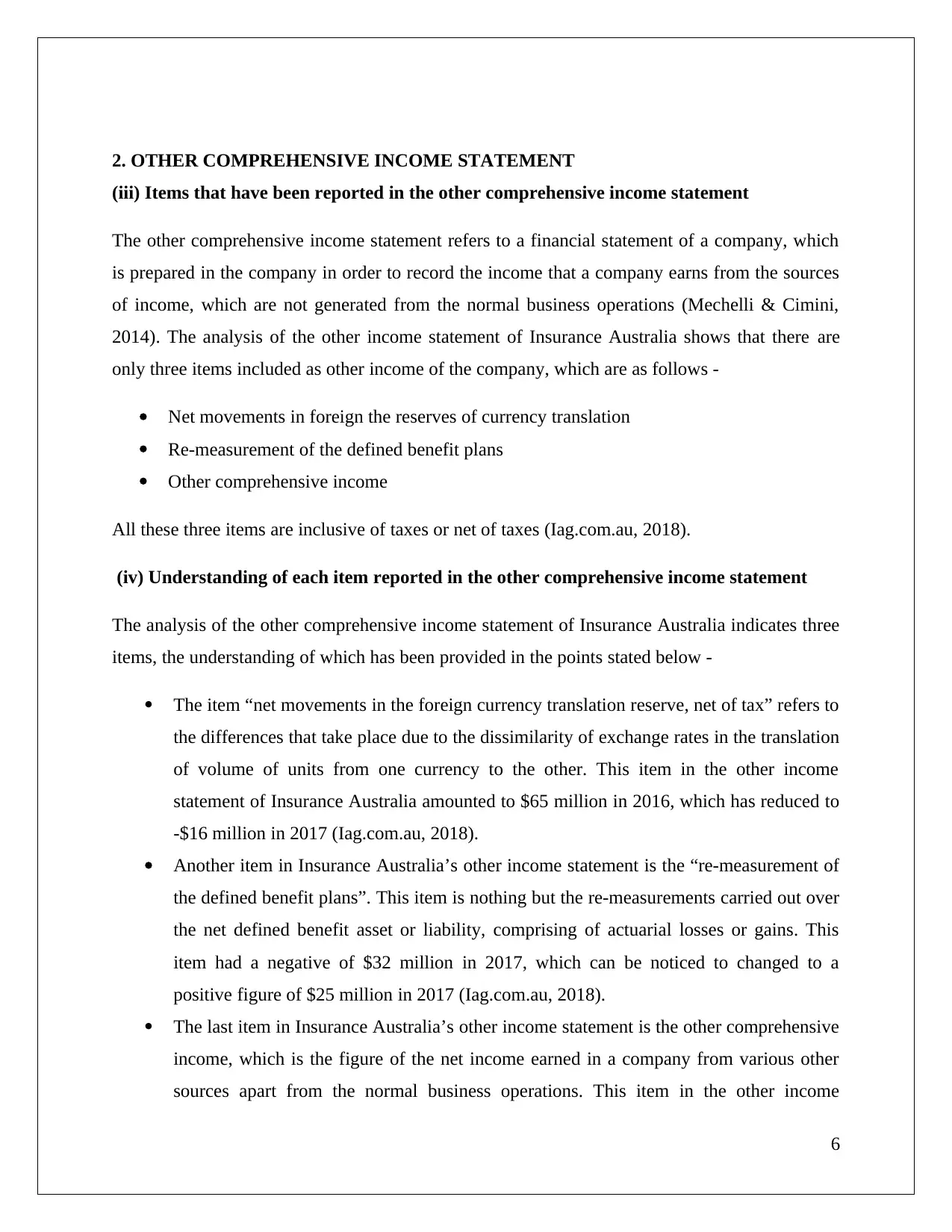
2. OTHER COMPREHENSIVE INCOME STATEMENT
(iii) Items that have been reported in the other comprehensive income statement
The other comprehensive income statement refers to a financial statement of a company, which
is prepared in the company in order to record the income that a company earns from the sources
of income, which are not generated from the normal business operations (Mechelli & Cimini,
2014). The analysis of the other income statement of Insurance Australia shows that there are
only three items included as other income of the company, which are as follows -
Net movements in foreign the reserves of currency translation
Re-measurement of the defined benefit plans
Other comprehensive income
All these three items are inclusive of taxes or net of taxes (Iag.com.au, 2018).
(iv) Understanding of each item reported in the other comprehensive income statement
The analysis of the other comprehensive income statement of Insurance Australia indicates three
items, the understanding of which has been provided in the points stated below -
The item “net movements in the foreign currency translation reserve, net of tax” refers to
the differences that take place due to the dissimilarity of exchange rates in the translation
of volume of units from one currency to the other. This item in the other income
statement of Insurance Australia amounted to $65 million in 2016, which has reduced to
-$16 million in 2017 (Iag.com.au, 2018).
Another item in Insurance Australia’s other income statement is the “re-measurement of
the defined benefit plans”. This item is nothing but the re-measurements carried out over
the net defined benefit asset or liability, comprising of actuarial losses or gains. This
item had a negative of $32 million in 2017, which can be noticed to changed to a
positive figure of $25 million in 2017 (Iag.com.au, 2018).
The last item in Insurance Australia’s other income statement is the other comprehensive
income, which is the figure of the net income earned in a company from various other
sources apart from the normal business operations. This item in the other income
6
(iii) Items that have been reported in the other comprehensive income statement
The other comprehensive income statement refers to a financial statement of a company, which
is prepared in the company in order to record the income that a company earns from the sources
of income, which are not generated from the normal business operations (Mechelli & Cimini,
2014). The analysis of the other income statement of Insurance Australia shows that there are
only three items included as other income of the company, which are as follows -
Net movements in foreign the reserves of currency translation
Re-measurement of the defined benefit plans
Other comprehensive income
All these three items are inclusive of taxes or net of taxes (Iag.com.au, 2018).
(iv) Understanding of each item reported in the other comprehensive income statement
The analysis of the other comprehensive income statement of Insurance Australia indicates three
items, the understanding of which has been provided in the points stated below -
The item “net movements in the foreign currency translation reserve, net of tax” refers to
the differences that take place due to the dissimilarity of exchange rates in the translation
of volume of units from one currency to the other. This item in the other income
statement of Insurance Australia amounted to $65 million in 2016, which has reduced to
-$16 million in 2017 (Iag.com.au, 2018).
Another item in Insurance Australia’s other income statement is the “re-measurement of
the defined benefit plans”. This item is nothing but the re-measurements carried out over
the net defined benefit asset or liability, comprising of actuarial losses or gains. This
item had a negative of $32 million in 2017, which can be noticed to changed to a
positive figure of $25 million in 2017 (Iag.com.au, 2018).
The last item in Insurance Australia’s other income statement is the other comprehensive
income, which is the figure of the net income earned in a company from various other
sources apart from the normal business operations. This item in the other income
6
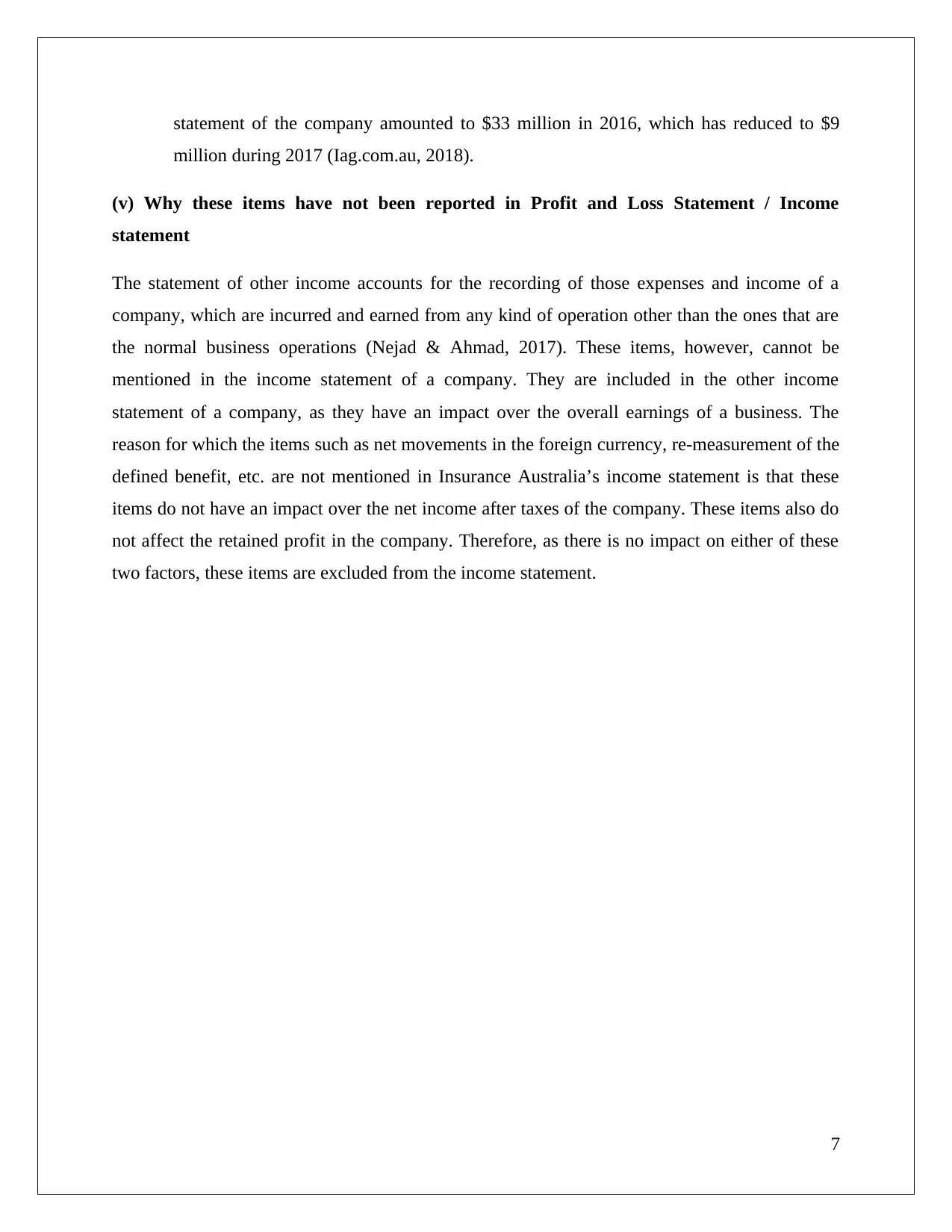
statement of the company amounted to $33 million in 2016, which has reduced to $9
million during 2017 (Iag.com.au, 2018).
(v) Why these items have not been reported in Profit and Loss Statement / Income
statement
The statement of other income accounts for the recording of those expenses and income of a
company, which are incurred and earned from any kind of operation other than the ones that are
the normal business operations (Nejad & Ahmad, 2017). These items, however, cannot be
mentioned in the income statement of a company. They are included in the other income
statement of a company, as they have an impact over the overall earnings of a business. The
reason for which the items such as net movements in the foreign currency, re-measurement of the
defined benefit, etc. are not mentioned in Insurance Australia’s income statement is that these
items do not have an impact over the net income after taxes of the company. These items also do
not affect the retained profit in the company. Therefore, as there is no impact on either of these
two factors, these items are excluded from the income statement.
7
million during 2017 (Iag.com.au, 2018).
(v) Why these items have not been reported in Profit and Loss Statement / Income
statement
The statement of other income accounts for the recording of those expenses and income of a
company, which are incurred and earned from any kind of operation other than the ones that are
the normal business operations (Nejad & Ahmad, 2017). These items, however, cannot be
mentioned in the income statement of a company. They are included in the other income
statement of a company, as they have an impact over the overall earnings of a business. The
reason for which the items such as net movements in the foreign currency, re-measurement of the
defined benefit, etc. are not mentioned in Insurance Australia’s income statement is that these
items do not have an impact over the net income after taxes of the company. These items also do
not affect the retained profit in the company. Therefore, as there is no impact on either of these
two factors, these items are excluded from the income statement.
7
Secure Best Marks with AI Grader
Need help grading? Try our AI Grader for instant feedback on your assignments.

3. ACCOUNTING FOR CROPORATE INCOME TAX
(vi) Firm’s tax expense in its latest financial statements
Income tax expenses can be referred to as the expense or the amount that a firm pays to the
government of the country in which it operates and is recorded under the income statement of
every firm (Lee et al., 2017). The tax expense of Insurance Australia, as recorded in the
company’s income statement, amounts to $329 million during the past accounting year 2017
(Iag.com.au, 2018). The latest financial statements of the company Insurance Australia Group
Limited also show that the income tax expense of the company had amounted to $218 million
during the year 2016 (Iag.com.au, 2018).
(vii) Is this figure the same as the company tax rate times your firm’s accounting income?
Explain why this is, or is not, the case for your firm
As per the rate of tax, which is mandatory to be paid to the government of all the public limited
companies listed under the ASX, is 30% (Burkhauser, Hahn & Wilkins, 2015). The company
Insurance Australia Group Limited is also liable to be paying income tax on the accounting profit
earned by it at the rate of 30%. However, if the figure of the tax expense of Insurance Australia
Group’s latest financial reports is considered, it can be reviewed that the tax expense stated in the
income statement of the company is higher than the taxable amount if the tax rate is 30%
(Iag.com.au, 2018). This shows that the figure of tax expense of Insurance Australia Group
Limited is not the same as the tax rate times of its accounting income.
However, the analysis of the notes to accounts of the company shows why and how the figure is
different. The taxes of the company have been calculated at 30% tax rate itself. However, the
difference has taken place since the company has adjusted amounts that are not taxable such as
difference in the rate of tax, rebateable dividends, etc., due to which the company tax rate times
of accounting income and the tax expense figure of Insurance Australia during the previous
financial year differ from one another. The following image shows the breakdown of the tax
expense of Insurance Australia Group Limited during the last two years -
8
(vi) Firm’s tax expense in its latest financial statements
Income tax expenses can be referred to as the expense or the amount that a firm pays to the
government of the country in which it operates and is recorded under the income statement of
every firm (Lee et al., 2017). The tax expense of Insurance Australia, as recorded in the
company’s income statement, amounts to $329 million during the past accounting year 2017
(Iag.com.au, 2018). The latest financial statements of the company Insurance Australia Group
Limited also show that the income tax expense of the company had amounted to $218 million
during the year 2016 (Iag.com.au, 2018).
(vii) Is this figure the same as the company tax rate times your firm’s accounting income?
Explain why this is, or is not, the case for your firm
As per the rate of tax, which is mandatory to be paid to the government of all the public limited
companies listed under the ASX, is 30% (Burkhauser, Hahn & Wilkins, 2015). The company
Insurance Australia Group Limited is also liable to be paying income tax on the accounting profit
earned by it at the rate of 30%. However, if the figure of the tax expense of Insurance Australia
Group’s latest financial reports is considered, it can be reviewed that the tax expense stated in the
income statement of the company is higher than the taxable amount if the tax rate is 30%
(Iag.com.au, 2018). This shows that the figure of tax expense of Insurance Australia Group
Limited is not the same as the tax rate times of its accounting income.
However, the analysis of the notes to accounts of the company shows why and how the figure is
different. The taxes of the company have been calculated at 30% tax rate itself. However, the
difference has taken place since the company has adjusted amounts that are not taxable such as
difference in the rate of tax, rebateable dividends, etc., due to which the company tax rate times
of accounting income and the tax expense figure of Insurance Australia during the previous
financial year differ from one another. The following image shows the breakdown of the tax
expense of Insurance Australia Group Limited during the last two years -
8
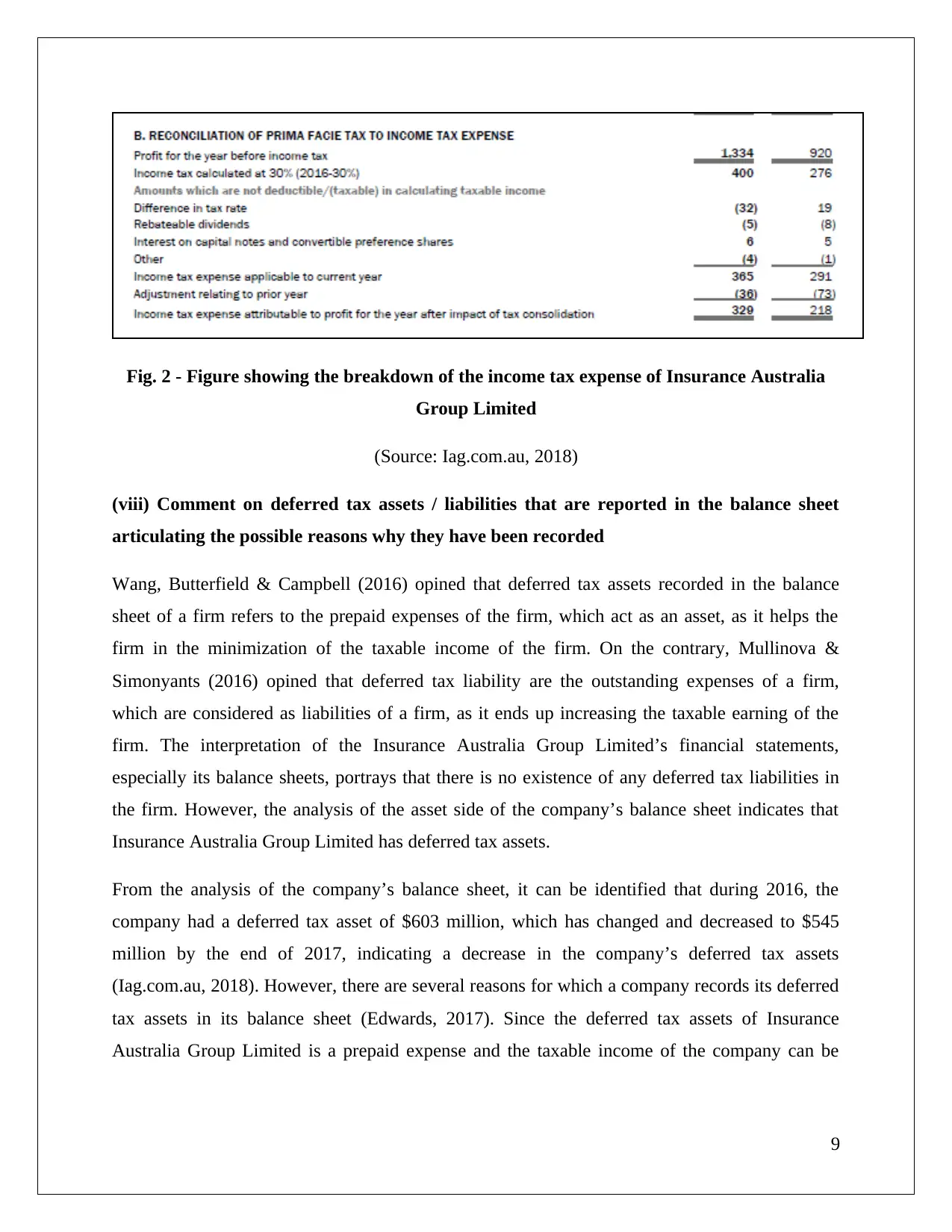
Fig. 2 - Figure showing the breakdown of the income tax expense of Insurance Australia
Group Limited
(Source: Iag.com.au, 2018)
(viii) Comment on deferred tax assets / liabilities that are reported in the balance sheet
articulating the possible reasons why they have been recorded
Wang, Butterfield & Campbell (2016) opined that deferred tax assets recorded in the balance
sheet of a firm refers to the prepaid expenses of the firm, which act as an asset, as it helps the
firm in the minimization of the taxable income of the firm. On the contrary, Mullinova &
Simonyants (2016) opined that deferred tax liability are the outstanding expenses of a firm,
which are considered as liabilities of a firm, as it ends up increasing the taxable earning of the
firm. The interpretation of the Insurance Australia Group Limited’s financial statements,
especially its balance sheets, portrays that there is no existence of any deferred tax liabilities in
the firm. However, the analysis of the asset side of the company’s balance sheet indicates that
Insurance Australia Group Limited has deferred tax assets.
From the analysis of the company’s balance sheet, it can be identified that during 2016, the
company had a deferred tax asset of $603 million, which has changed and decreased to $545
million by the end of 2017, indicating a decrease in the company’s deferred tax assets
(Iag.com.au, 2018). However, there are several reasons for which a company records its deferred
tax assets in its balance sheet (Edwards, 2017). Since the deferred tax assets of Insurance
Australia Group Limited is a prepaid expense and the taxable income of the company can be
9
Group Limited
(Source: Iag.com.au, 2018)
(viii) Comment on deferred tax assets / liabilities that are reported in the balance sheet
articulating the possible reasons why they have been recorded
Wang, Butterfield & Campbell (2016) opined that deferred tax assets recorded in the balance
sheet of a firm refers to the prepaid expenses of the firm, which act as an asset, as it helps the
firm in the minimization of the taxable income of the firm. On the contrary, Mullinova &
Simonyants (2016) opined that deferred tax liability are the outstanding expenses of a firm,
which are considered as liabilities of a firm, as it ends up increasing the taxable earning of the
firm. The interpretation of the Insurance Australia Group Limited’s financial statements,
especially its balance sheets, portrays that there is no existence of any deferred tax liabilities in
the firm. However, the analysis of the asset side of the company’s balance sheet indicates that
Insurance Australia Group Limited has deferred tax assets.
From the analysis of the company’s balance sheet, it can be identified that during 2016, the
company had a deferred tax asset of $603 million, which has changed and decreased to $545
million by the end of 2017, indicating a decrease in the company’s deferred tax assets
(Iag.com.au, 2018). However, there are several reasons for which a company records its deferred
tax assets in its balance sheet (Edwards, 2017). Since the deferred tax assets of Insurance
Australia Group Limited is a prepaid expense and the taxable income of the company can be
9

reducing in future due to this prepaid expense, it can be articulated that the company records
deferred tax assets in its balance sheet, as it can reducing its taxable income.
10
deferred tax assets in its balance sheet, as it can reducing its taxable income.
10
Paraphrase This Document
Need a fresh take? Get an instant paraphrase of this document with our AI Paraphraser
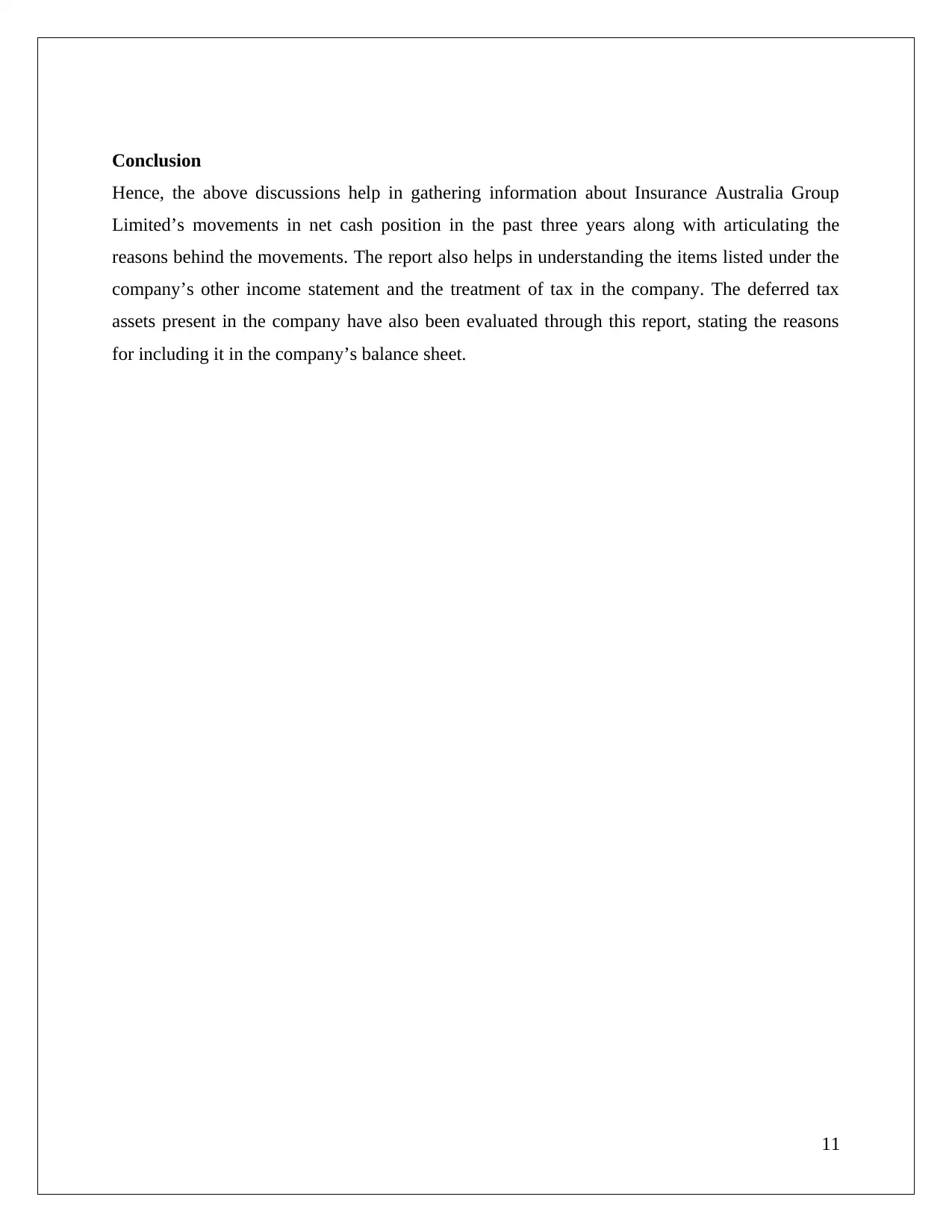
Conclusion
Hence, the above discussions help in gathering information about Insurance Australia Group
Limited’s movements in net cash position in the past three years along with articulating the
reasons behind the movements. The report also helps in understanding the items listed under the
company’s other income statement and the treatment of tax in the company. The deferred tax
assets present in the company have also been evaluated through this report, stating the reasons
for including it in the company’s balance sheet.
11
Hence, the above discussions help in gathering information about Insurance Australia Group
Limited’s movements in net cash position in the past three years along with articulating the
reasons behind the movements. The report also helps in understanding the items listed under the
company’s other income statement and the treatment of tax in the company. The deferred tax
assets present in the company have also been evaluated through this report, stating the reasons
for including it in the company’s balance sheet.
11
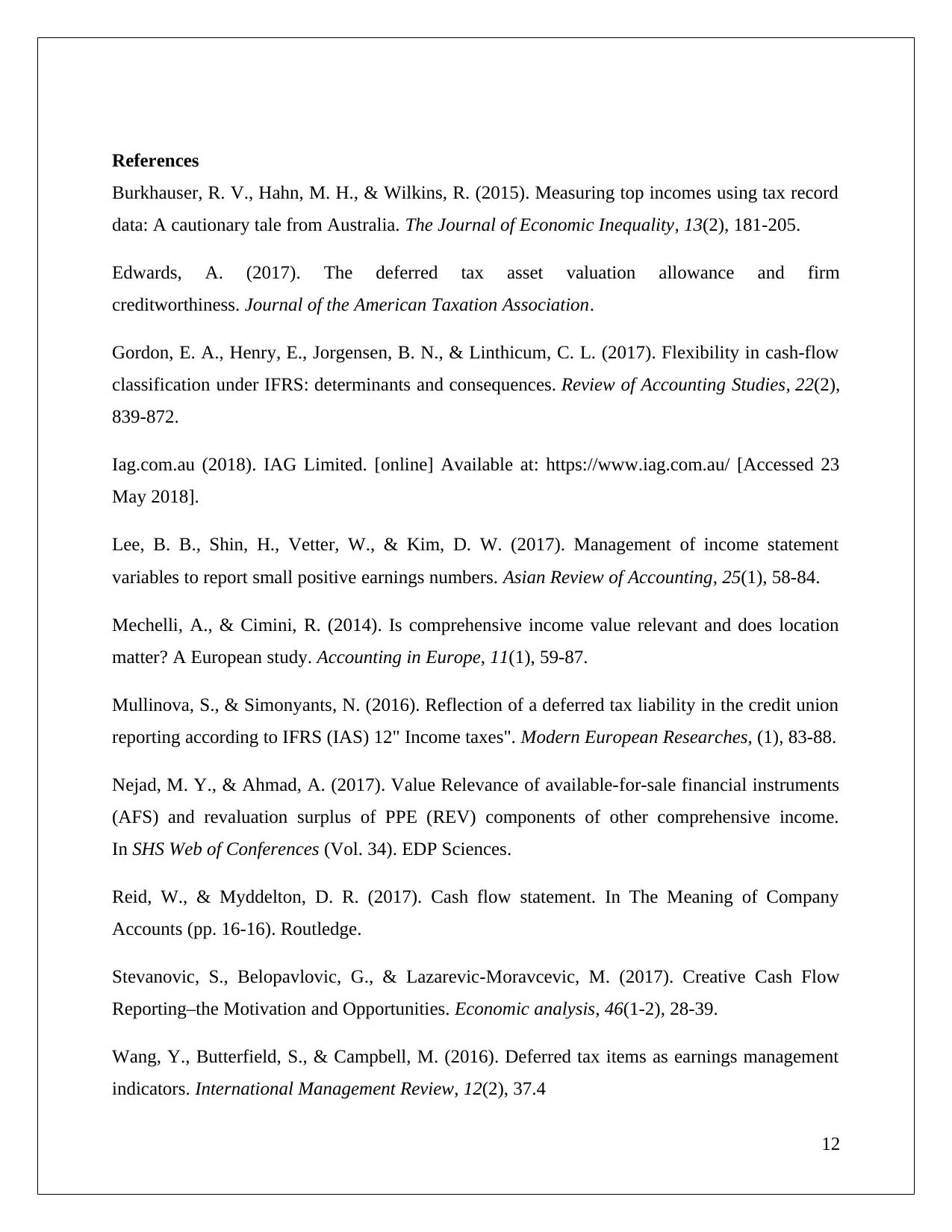
References
Burkhauser, R. V., Hahn, M. H., & Wilkins, R. (2015). Measuring top incomes using tax record
data: A cautionary tale from Australia. The Journal of Economic Inequality, 13(2), 181-205.
Edwards, A. (2017). The deferred tax asset valuation allowance and firm
creditworthiness. Journal of the American Taxation Association.
Gordon, E. A., Henry, E., Jorgensen, B. N., & Linthicum, C. L. (2017). Flexibility in cash-flow
classification under IFRS: determinants and consequences. Review of Accounting Studies, 22(2),
839-872.
Iag.com.au (2018). IAG Limited. [online] Available at: https://www.iag.com.au/ [Accessed 23
May 2018].
Lee, B. B., Shin, H., Vetter, W., & Kim, D. W. (2017). Management of income statement
variables to report small positive earnings numbers. Asian Review of Accounting, 25(1), 58-84.
Mechelli, A., & Cimini, R. (2014). Is comprehensive income value relevant and does location
matter? A European study. Accounting in Europe, 11(1), 59-87.
Mullinova, S., & Simonyants, N. (2016). Reflection of a deferred tax liability in the credit union
reporting according to IFRS (IAS) 12" Income taxes". Modern European Researches, (1), 83-88.
Nejad, M. Y., & Ahmad, A. (2017). Value Relevance of available-for-sale financial instruments
(AFS) and revaluation surplus of PPE (REV) components of other comprehensive income.
In SHS Web of Conferences (Vol. 34). EDP Sciences.
Reid, W., & Myddelton, D. R. (2017). Cash flow statement. In The Meaning of Company
Accounts (pp. 16-16). Routledge.
Stevanovic, S., Belopavlovic, G., & Lazarevic-Moravcevic, M. (2017). Creative Cash Flow
Reporting–the Motivation and Opportunities. Economic analysis, 46(1-2), 28-39.
Wang, Y., Butterfield, S., & Campbell, M. (2016). Deferred tax items as earnings management
indicators. International Management Review, 12(2), 37.4
12
Burkhauser, R. V., Hahn, M. H., & Wilkins, R. (2015). Measuring top incomes using tax record
data: A cautionary tale from Australia. The Journal of Economic Inequality, 13(2), 181-205.
Edwards, A. (2017). The deferred tax asset valuation allowance and firm
creditworthiness. Journal of the American Taxation Association.
Gordon, E. A., Henry, E., Jorgensen, B. N., & Linthicum, C. L. (2017). Flexibility in cash-flow
classification under IFRS: determinants and consequences. Review of Accounting Studies, 22(2),
839-872.
Iag.com.au (2018). IAG Limited. [online] Available at: https://www.iag.com.au/ [Accessed 23
May 2018].
Lee, B. B., Shin, H., Vetter, W., & Kim, D. W. (2017). Management of income statement
variables to report small positive earnings numbers. Asian Review of Accounting, 25(1), 58-84.
Mechelli, A., & Cimini, R. (2014). Is comprehensive income value relevant and does location
matter? A European study. Accounting in Europe, 11(1), 59-87.
Mullinova, S., & Simonyants, N. (2016). Reflection of a deferred tax liability in the credit union
reporting according to IFRS (IAS) 12" Income taxes". Modern European Researches, (1), 83-88.
Nejad, M. Y., & Ahmad, A. (2017). Value Relevance of available-for-sale financial instruments
(AFS) and revaluation surplus of PPE (REV) components of other comprehensive income.
In SHS Web of Conferences (Vol. 34). EDP Sciences.
Reid, W., & Myddelton, D. R. (2017). Cash flow statement. In The Meaning of Company
Accounts (pp. 16-16). Routledge.
Stevanovic, S., Belopavlovic, G., & Lazarevic-Moravcevic, M. (2017). Creative Cash Flow
Reporting–the Motivation and Opportunities. Economic analysis, 46(1-2), 28-39.
Wang, Y., Butterfield, S., & Campbell, M. (2016). Deferred tax items as earnings management
indicators. International Management Review, 12(2), 37.4
12
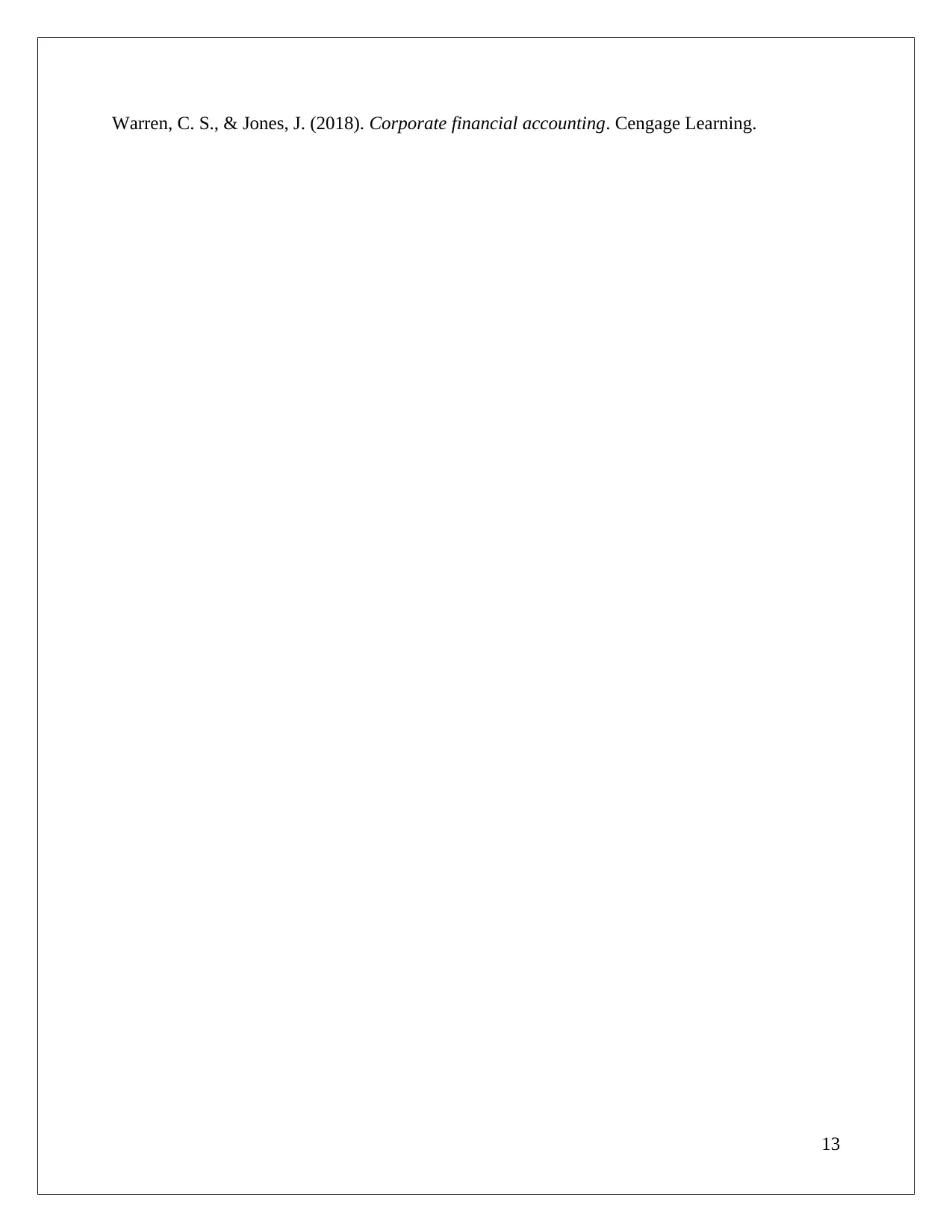
Warren, C. S., & Jones, J. (2018). Corporate financial accounting. Cengage Learning.
13
13
1 out of 13
![[object Object]](/_next/static/media/star-bottom.7253800d.svg)





